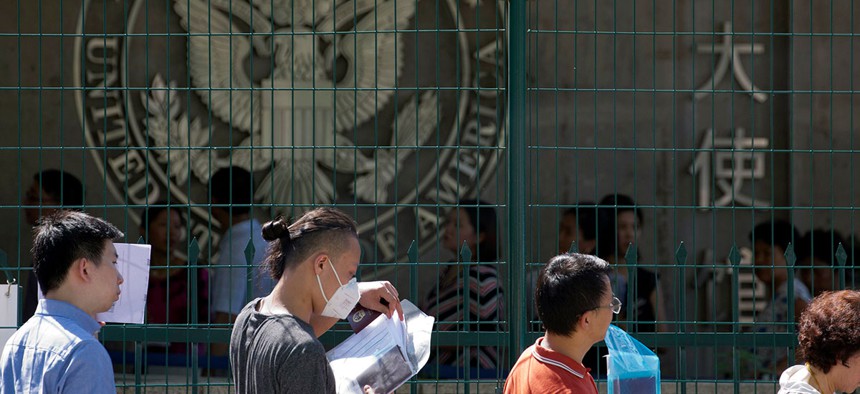
Visa applicants wait to enter the U.S. Embassy in Beijing in 2018. Ng Han Guan/AP file photo
The Real Illegal Immigration Crisis Isn’t on the Southern Border
Focusing on asylum seekers who cross land borders ignores the real problem: people who overstay their visas.
If curbing illegal immigration is the goal, as politicians in the United States and Europe argue, then no wall or border fence will stop the West’s largest source of such immigrants. They are not the subject of televised debates or of long stories highlighting their plight. Many are invisible, making them hard to count, and little attention is paid to them. Yet focusing on them might yield better results than focusing on those fleeing violence and persecution.
The group in question? Visa overstays.
These immigrants, who enter countries legally on student, tourist, or work visas and then stay past their visa’s expiration date, are often overlooked in the discussion of illegal immigration. But in the past 10 years, visa overstays in the United States have outnumbered border crossings by a ratio of about 2 to 1, according to Robert Warren, who was for a decade the director of the statistics division at the agency that has since been renamed U.S. Citizenship and Immigration Services, and who is now a senior visiting fellow at the Center for Migration Studies, a New York–based organization. Elsewhere, the issue is even more pronounced—in Britain and Australia, the absence of a land border of the kind the United States has with Mexico and Canada means that nearly all illegal immigration comes in the form of visa overstays. Most people who are in Britain illegally, for example, entered legally and simply stayed on after their visa expired, research by Oxford University’s Migration Observatory shows.
Still, none of this has translated into visa overstays becoming a source of anti-immigrant sentiment. Immigration, especially in the U.S. and Europe, has become shorthand for the perceived uncontrolled flow of immigrants across land borders. In the U.S., Donald Trump has railed against “Mexicans” (though illegal border crossings by Mexican nationals are at multi-decade lows) and the thousands of people from Central America’s Northern Triangle (Guatemala, Honduras, and El Salvador) who are seeking asylum. In Europe, the populist backlash to the entry of more than 1 million people from Syria and elsewhere in 2014 and 2015 resulted in even mainstream parties espousing a more restrictionist immigration policy.
“It’s right out there in the news, and you can see people” crossing borders, Warren told me. “With the overstayers, people will be tourists and they’ll come here, and they’ll either join relatives or they’ll join people they know, and they’ll get a job, and they’re not visible.”
The practice of pointing to a visible facet of a social problem—such as immigrants massing at a border—is hardly isolated when it comes to policy making. It is far easier to call for gun control or restricting the sale of violent video games after a mass shooting than to formulate more complex and coherent policies that might be more effective.
That could be changing, however, at least in the U.S. The Wall Street Journalreported this week that the Trump administration, which has restricted its public statements, if not its actual policies, to illegal border crossings, now might be turning its attention to overstayers. Its specific focus may be the B1 and B2 visas, which are awarded to people visiting the country on business and tourism, respectively. Under the reported plan, the U.S. would put the nations with the highest overstay rates, based on Department of Homeland Security data—Chad, Liberia, Nigeria, and Sierra Leone—“on notice,” and tell them that unless the numbers change, their citizens would find it harder, maybe even impossible, to obtain visas.
In the U.S., visa overstays have exceeded illegal border crossings in each of the past seven years. In 2016, about 515,000 people arrived in the United States illegally, the Center for Migration Studies said in a report. Of these, 320,000, more than three-fifths, overstayed their visas, and the rest crossed a land border illegally. But tracking people who enter the U.S. legally until they leave is difficult. The Department of Homeland Security conducted its own analysis for fiscal year 2017, and its estimate was 702,000 overstayers. (To be clear, that number is a small fraction, 1.33 percent, of the more than 50 million people who arrive in the U.S. each year on valid visas.)
Part of the reason the numbers are hard to track is that visitors’ visas are not checked as they exit some countries and, when they are, the system is either incomplete or problematic. In the U.S., Congress has mandated that authorities track those who are leaving the country, but the reliability of the data is unclear; in the U.K., which instituted exit checks in 2015, the process has been called “shambolic.”
The situation is more complicated elsewhere in Europe. The EU allows its citizens to move, live, and work freely across its member states. Some EU members also belong to the Schengen area, which allows for borderless travel—visitors can cross, for example, between France and Germany without having their passport checked. This lack of borders, in theory, allows someone who arrives in one Schengen country with a valid visa to move to another and remain there well after that visa expires. Collecting data on visa overstays in the EU is difficult, but they are likely the main source of its illegal immigration, according to the European Commission.
The Trump administration’s goal of reducing overstay rates is in line with its pledge to cut overall illegal immigration. As Hogan Gidley, a White House spokesman, told the Associated Press: “It is a top priority” for the president. But, even if the administration’s efforts are effective, they are unlikely to garner headlines.






